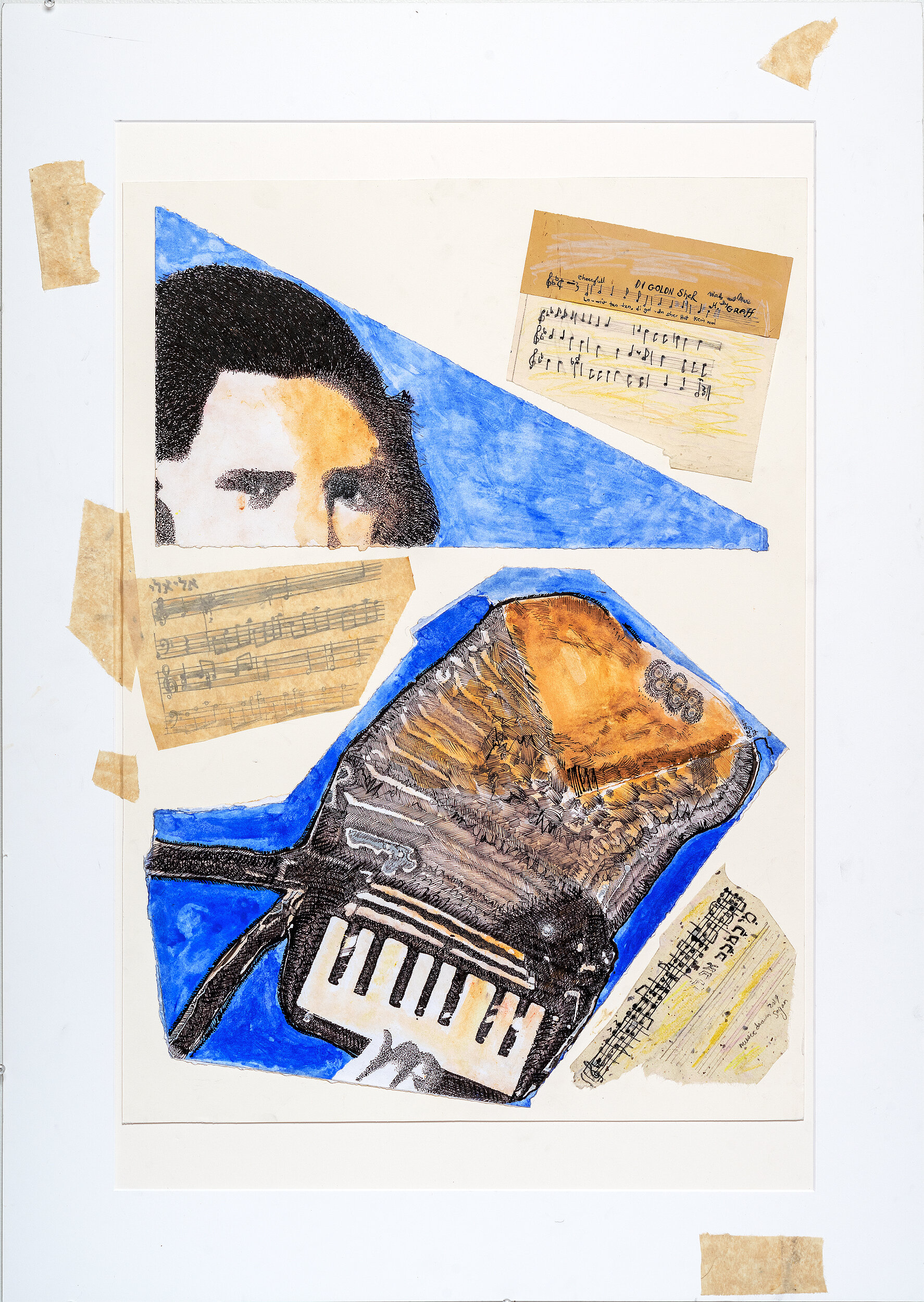Art © A K Segan
UTW 56
Nazi victims: Fiorella Anticoli of Rome, Jewish girl with accordion
Art: The face and the accordion sections were drawn in 2007. The three music sections were drawn in October 2019.
Media: Ink, gouache, pencil.
Framed, 45 in. H x 32.5 H
Drawn from a photo of Fiorella taken when she was 12 years of age; I first saw the photo at the Children's Museum at Yad Vashem in Jerusalem, 1999.
~
She was Jewish, from Rome, Italy. She played the accordion. Fiorella was murdered at the Bergen-Belsen Nazi concentration camp in Germany, 1945.
~
The original photo is in the collection of the Centro di Documentazione Ebraica Contemporanea (aka CDEC), Milan, Italy. The photo (and text about her life) is published in The Italians and the Holocaust – Persecution, Rescue, Survival, by Susan Zuccotti (pub. By Basic Books, N.Y., 1987)
~
According to Ms. Zuccoti in The Italians and the Holocaust, the first roundup of Jews in Rome was on October 16, 1943. At the time, Rome's Jewish population was 12,000; four thousand were in the ghetto and were arrested that day.
~
The following is excerpted from a letter I received from a CDEC staffer, dated 23 July 2002:
“Fiorella was born in Rome, Aug. 13, 1931. She was the daughter of Marco and Frascati Ester. She was arrested in the family roundup of Oct. 16, 1943 by the Nazis, with her family: her mother, aunts, uncles, brothers, and grandparents.
She was interned in the Collegio Militare, and on the 18th deported, via a minor railway station in Rome, directly to Auschwitz-Birkenau. She was fortunate to not be gassed. Probably at the end of December 1944, she was sent to the Bergen-Belsen concentration camp in Germany. [Starved and sick], she died, after liberation, on May 31, 1945.”
~
AKS note: I had read elsewhere that American GI’s photographed with her as they tried to sae her. The photo was published in newspapers in different cities in Europe, including Rome. Her father [who had had survived the roundup of Jewish people in Rome, where he remained through the war, according to the CDC] saw the photo in Rome and hoped for her survival…
~
In October 2019 I decided to do something with the blank areas around the figure and accordion.
I debated whether to draw wings. I decided to draw music:
One section is a bar from the song “Eli, Eli” (My God, My God). The melody was composed in post-WWII, post independence Israel to poetry penned by Hannah Senesh, a young (born 1921) Hungarian born Jewish woman and resistance fighter who was executed by the Nazis. In 1939 she had emigrated to pre-state Israel, then the British Mandate of Palestine. In 1943, in Palestine, she enlisted in the British Women's Auxiliary Air Force. In 1944 she parachuted into Yugoslavia, then made her way to the Hungarian border. Arrested, she was eventually executed by a firing squad on Nov. 7, 1944.
~
In another section I drew a bar from the Hebrew song Mi Chomocho Aw Horachamim. The song is seen on page 28 in a songbook I’d bought somewhere: “Songs of Israel, Famous Traditional Hebrew Melodies,” pub. 1938 by Leon Feist, Inc., NY, NY.
~
The third song except, at upper right, I copied from music composed, with lyrics by my late maternal grandfather, Harry Graff of Englewood, NJ. Born around 1880-1881 near Bialystok, Poland, Graff emigrated to London around 1903 and to the US around 1905.
My granddad Harry’s murdered mother, and a brother of my granddad, whose name was Liebl, is seen in three artworks:
~
A 4 min., 4 sec. video of the drawing.
~
A 7 min., 53 sec. video of the drawing.
